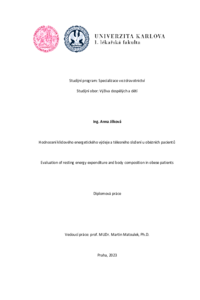Hodnocení klidového energetického výdeje a tělesného složení u obézních pacientů
Evaluation of resting energy expenditure and body composition in obese patients
diploma thesis (DEFENDED)

View/
Permanent link
http://hdl.handle.net/20.500.11956/184036Identifiers
Study Information System: 252152
Collections
- Kvalifikační práce [4869]
Author
Advisor
Referee
Zelinka, Tomáš
Faculty / Institute
First Faculty of Medicine
Discipline
Child and Adult Nutrition
Department
3rd Department of Medicine - Department of Endocrinology and Metabolism First Faculty of Medicine Charles University and General University Hospital in Prague
Date of defense
5. 9. 2023
Publisher
Univerzita Karlova, 1. lékařská fakultaLanguage
Czech
Grade
Excellent
Keywords (Czech)
obezita, energetický výdej, redukce hmotnosti, nepřímá kalorimetrieKeywords (English)
obesity, energy expenditure, weight loss, indirect calorimetryÚvod: Základem léčby obezity je konzervativní režim založený na redukčním jídelníčku a pohybové aktivitě, individuálně nastavený pro každého jedince. Jelikož obézní často vykazují extrémní odchylky v tělesné kompozici oproti jedincům s normální váhou, je často těžké nastavit jejich energetickou potřebu či zjistit jejich výdej energie. Ke zlatému standardu zjištění klidového energetického výdeje (RMR) patří vyšetření pomocí nepřímé kalorimetrie. Tato metoda může také odhalit odchylky od výpočtů prediktivních rovnic, zjistit míru adaptace jedince na nízký energetický příjem, a tak nastavit vhodnou terapii. Cíle: Hlavním cílem práce je analýza a popis dat o tělesném složení a hodnotách klidového energetického výdeje vybraných skupin obézních jedinců, jejichž výsledky měření RMR pomocí nepřímé kalorimetrie dosahovaly úrovně pod 95 % predikovaného RMR vypočítaného pomocí rovnice Harrise Benedicta. Dílčími cíli je popsat závislost velikosti některých komponentů tělesného složení na velikosti RMR a zjistit, jestli odchylky mezi velikostí celkového naměřeného RMR a RMR vypočítaného pomocí H-B u adaptované skupiny jsou významné. Metodika: Do výzkumu bylo vybráno 71 pacientů III. interní kliniky 1. LF UK a VFN v Praze s body mass indexem ≥ 30 kg/m2 . Výzkumný soubor se skládal z 39 žen a 32 mužů s průměrným...
Introduction: The basis of obesity treatment is a conservative regimen based on a reduced diet and physical activity, individually set for each person. As the obese often show extreme deviations in body composition compared to individuals of normal weight, it is often difficult to determine their energy needs or determine their energy expenditure. The gold standard for determining resting energy expenditure (REE) is examination using indirect calorimetry (IC). This method can also detect deviations from the calculations of predictive equations, determine the degree of adaptation of the individual to low energy intake, and thus set the appropriate therapy. Objectives: The main objective of the work is the analysis and description of data on body composition and resting energy expenditure values of selected groups of obese individuals whose REE measurement results using indirect calorimetry reached a level below 95 % of the predicted REE calculated using the Harris Benedict (H-B) equation. The sub-goals are to describe the dependence of the size of some components of body composition on the size of the REE and to find out if the deviations between the number of the total measured REE and the REE calculated using H-B in the adapted group are significant. Methodology: For the research 71 patients of...
